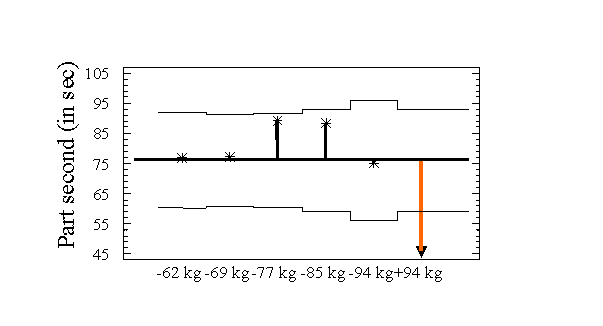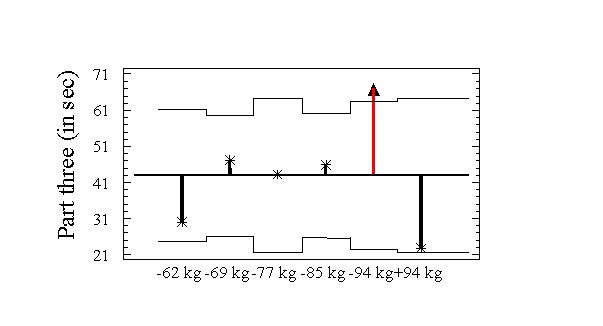By Stanislaw Sterkowicz and Tadeusz Ambrozy |
IntroductionA number of ways have been developed in combat sports to observe and analyse the course of sports competition (Sterkowicz and Kesek 1983, Sterkowicz 1992, Sterkowicz and Maslej 1999ab). On one hand, their goal has been to determine the schooling trends in a given country, and on the other, to obtain the characteristics of individual or group activities during competitions, for example, according to the weight category or the level of achievements in sports (Sterkowicz 1992). Ju-jitsu, which evolved from brutal hand to hand combat (Kondratowicz 1991, Witkowski 1993, Sterkowicz 1998) has been turned into a sport in recent years and its rules emphasise the all-round development of technical and tactical schooling. Both attacks in a long distance (punches with the upper and lower limbs) are permissible as they are in clinch (throwing techniques) and grappling techniques in groundwork (analogically to Judo – locking, holding, and choking techniques). The fight takes place in two rounds lasting for two minutes. In this new discipline of sport, there is no specialist evaluation of the course of participation in competitions, which clearly determines the manner of training in sports clubs The objective of this paper is to characterise the course of sports combat with a particular regard to the temporal structure of effort as well as the effectiveness of technical elements in different weight categories Material and methodThe video recording of fights during, the VIII Individual Seniors’ Championships of Poland in Katowice (1999) constituted the material for this research. In the tournament, there were 84 competitors, who belonged to the current leading athletes of the Polish and the World’s Ju-jitsu ( e.g. D. Zimolog – the present World champion of heavy weight category). The competitions were held in 6 weight categories (-62 kg, -69kg, -77 kg, -85kg, -94kg and +94kg), according to the regulations of the Polish Ju-jitsu Association (an adaptation of International Ju-jitsu Competition Rules for Free Fighting – Hickey 1996). Two competent authors (holders of 6th Dan in Ju-jitsu) analysed the bouts, recorded with the aid of three VHS cameras (included all weight categories from the elimination fights to the finals). The duration of fights were recorded along with the intermissions that occurred during them. Table 1. The number of fights in particular weight categories
Both the temporal and material structure of sports combat was analysed in order to isolate the specific nature of the course of the competitions in particular weight categories. At the beginning, the percentage index of time utilization during fight was calculated (Sikorski 1985), which is a ratio between the total duration of fight in real-time and the theoretical, maximum time of combat. The fight was divided into three fragments according to the statutory parts in order to analyse its temporal structure. The time in the first part of the fight in the standing position (in long distance) was measured from the referee’s announcement of Hajime up to the announcement of Matte , or at the moment when a grip was applied on the opponent (the beginning of the second part). This fragment lasted to the announcement of Matte. When the contestant undertook fight in the third part – in groundwork – the measurement of the time in Ne-waza. was commenced. However, the time of breaks between efforts was measured from the announcement of Matte to that of Hajime. When reproducing the course of individual fights with the help of a stopwatch to the nearest 0.01 of a second, time measurements were taken of:
In the research on the material structure, the quality of actions was analysed. We isolated the type of attack (the name of technique), the side of its execution, (to the right, left of the attacked contestant), the verdict of the judges (Wazaari – 1 point Ippon, – 2 points as well as penalties (Shido, Chui, Keikoku, Hansoku-make that were imposed during particular parts of the fight with regard to the minutes that elapsed. The Sterkowicz and Kesek observation sheet (1983) for fight recording was adapted to the needs of this analysis of Ju-jitsu sports combat. Furthermore, we calculated :
The tactical situations were also analysed taking account of the place where an effective attack was executed (centre of the contest area, warning area). Discussion of the research findingsa) The temporal structure of fightJu-jitsu combat comprised periods of intensive efforts in the standing position and during groundwork as well as intermissions. The total time of fight, intermissions, and that of effective fight along with its three distinct parts were listed in Table 2. Table 2. Duration of fight and intermissions (in seconds) in Ju-jitsu matches
*- The judges extended the time of fight beyond 240 seconds, when a holding technique was applied during the last seconds and one was to wait for its outcome. The mean time of fight along with intermissions amounted to 253.9 seconds. The comparison of the mean values in the variance analysis did not reveal any significant differences between weight categories (F = 1,81; p > 0.05). The time of intermissions considerably differentiated the weight categories (F = 5.45; P < 0.001). Against the background of the total mean value (35.9 seconds), the longest periods of intermissions occurred in the case of the weight category up to 62 kg, while the shortest ones were present in the heaviest weight categories (figure. 1). 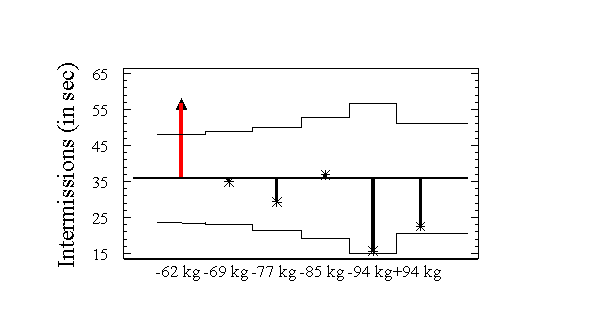 Figure 1. Differentiation of time during intermissions in the contestants of six weight categories The mean time of effective fight (measured without intermissions amounted to 220.6 seconds, and moreover, some significant differences were observed between the weight categories (F = 2.79; p < 0.05). The shortest time of effective fight occurred in the weight category above 94 kg (figure 2). The shortening of the time of fight in the heavy weight category was brought about by the fact that five fights were decided before the regular time thanks to the winning of three Ippons during different parts of fight on account of injuries. The contestants fought longest during the first part of the fight ( The duration of the first part of fight was not substantially different between particular weight categories (F = 0.17; p > 0.05). It was shown, however, that there was a significant diversification between the second and third part of fight in this regard (statistical values were F = 5.23; p < 0.001 and F = 3.43; p < 0.01 respectively). The rivalry to apply throwing techniques during the second part took the contestants from the weight category above 94 kg the least time. The fight during the third part in the category up to 94 kg went on considerably longer than in other weight categories. The differences resulting from the comparison of the mean time values were illustrated in figures 3 and 4. 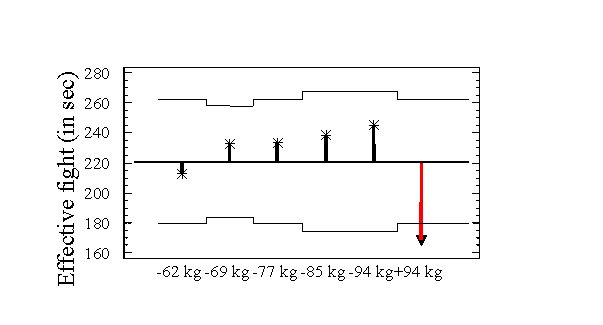 Figure 2. Diversification of the effective time of fight (without time-outs) between the contestants of six weight categories. Figure 3. Diversification of time of the second part of fight between the contestants of six weight categories. Figure 4. Diversification of time in the third part of fight between the contestants of six weight categories. The comparison of the selected temporal characteristics of fight in Ju-jitsu and Judo appears to be interesting. It follows from the present research that the contribution of the time of fight in the standing position (along with the first and the second part ) in Ju-jitsu (70.7%) was longer than in Judo (56%), whereas in groundwork it was similar (16.8 : 18.0%). The share of breaks in the total time of fight in Ju-jitsu was smaller (14.1%) than in Judo (26.0%) during which the average time was shorter (35.9 seconds : 10.3 seconds) (according to Sterkowicz and Maslej 1999a). The intermissions were caused by injuries to the body and they resulted from the rules of fight or the tactical behaviour of the contestants who, for example, would do up their Ju-jitsu Gi. The differences which were found between the representatives of both disciplines of sport could have also resulted from the manner of their all-round and specialist preparation. b)The material structure of fightWhen analysing the material structure of fight, it was discovered that the contestants executed 531 effective attacks in all. As it follows from table 3, the technique that were executed in the first part of fight constituted 75.1% of all the actions, in the second part 16.8%, and in the third part only 8.1%. The majority of points obtained occurred in the first period of fight, which may indicate to the coaches a profile of a specialist preparation of their contestants for the incoming championships. Table 3. The number of effective attacks and their scoring value in three parts of Ju-jitsu Kumite Matches.
Punches delivered with the hand (attacks with straight blows – 26.5% and hooks – 19%; which were calculated from n = 531) dominated during the first part of fight. Kicks were less frequently applied (Mae-geri –18%, Mawashi-geri – 7.9%, Yoko-geri – 3.6%). Among the effective techniques in the second part prevailed throwing techniques from the group of foot and leg techniques (Uchi-mata – 5.1%, De-ashi-barai – 1.5%, Ko-uchi-gari – 0.8% and O-soto-gari – 0.4%). Among the hand and arm throwing techniques – 4.5% was exclusively applied. Hip throwing techniques were represented by Harai-goshi – 3.8% and Ushiro-goshi – 0.2%, while throwing techniques involving a fall on the part the attacking contestant were represented by, Tomoe-nage – 0.6%. Holding techniques were most frequently applied during the fight in groundwork (the contestant was held lying on his back – 1.3% and holding technique (the opponent lying with his front towards the tatami – 0.8%) as well as leverage technique applied on the elbow joint Juji-gatame – 1.7%. This observation tallies with the tendencies prevailing in the Polish and the World’s Judo (Sterkowicz et al. 1997, Sterkowicz and Maslej 1999). Despite their small number, the techniques effectively executed in the third part of Ju-jitsu fight, had a higher scoring value (on average 2.1 points) than attacks during the first and second part of fight (1.3 and 1.8 points respectively). Therefore, during the technical and tactical preparation of contestants, one should especially stress the fragment of fight during groundwork – all the more so – that it occurs most frequently in the final part of the encounter and may be decisive of its final result. Probably the objective of training brought about the differentiation between weight categories. Taking into account the scoring effectiveness of attack, it was shown that it was the highest during the first part in the weight category above 94 kg (1.6 points); in the second part in weight categories: to 69 kg, to 77 kg and above 94 kg (1.9 points); in the third part – in weight category to 77 kg (2,4 points). It was found that the number of techniques that occurred on average in one fight was higher in Ju-jitsu than in Judo (Sterkowicz and Maslej 1999). The level of this index was connected with the application of short-lived punches in Ju-jitsu. The different rules of these disciplines of sport partly influenced the larger contribution of groundwork in the entire encounter, because one effective technique does not terminate a fight before its regular time as it is the case in Judo. The number of attacks in the consecutive minutes seems interesting from the schooling viewpoint. Thanks to this, it may be possible to characterise the activity of contestants that is changing with a lapse of time of fight (tab. 4). Table 4 The average number of attacks in the consecutive minutes of fight.
As it follows from table 4, the most of the attacks occurred at the beginning of the first two-minute round (on average 3.9 actions. The activity of the contestants during the second minute decreased to two attacks per minute. After one minute of the statutory intermission, there followed its increase during the third minute to 2.9 attacks per minute. Then it was possible to observe a decrease in the number of attacks during the fourth minute to 2 attacks per minute. The beginning of the first and second round constituted the first part of fight of the highest intensity of actions. We also observed a natural decrease in activities with a lapse of time and its increase in the interval. It was caused by an increasing fatigue and incapacity to rest fully between rounds. A relatively high index of activity during the final minute may be connected with the mobilisation of the competitors of 69, 77 and over 94 kg weight categories, who struggled to change the outcome of their fights before their terminations. When comparing the average number of attacks in Ju-jitsu and in Judo, it is possible to find fundamental differences in this respect, which is connected with a symptomatic course of the sports competition (Sterkowicz and Maslej 1999). The number of the obtained points that occurred in the consecutive minutes of Ju-jitsu fight were listed in table 5. Table 5. The average number of points in the consecutive minutes of Ju-jitsu fight.
In the first and the third minute of fight, the most effective attacks were executed by the contestants from the weight category of up to 94 kg. The contestants of weight of up to 85 kg were more effective in the second minute, while those from the weight category of up to 69 kg excelled in the fourth minute. It follows from the conducted analysis that the contestant participating in Ju-jitsu competitions should be perfectly prepared in terms of both technical and motor skills. The list of effective attacks in sports Ju-jitsu fight, which had been prepared earlier, reveals a desired pattern of the technical schooling in sports clubs. The percentage index of time utilization of Ju-jitsu fight in general amounted to 91.9% and it was the highest in the weight category of up to 94 kg (102.0%), whereas its lowest (best) value characterised the course of fight in weight category above 94 kg (70.2%). The overall index was considerably higher than in Judo fight (58.1% – according to Sterkowicz and Maslej 1999a). It is possible to suppose that it was a result of more complex techniques in Ju-jitsu, in which there additionally occurs a fragment of long distance fight that decides about an important contribution of the fight in the standing position towards the total effective time of activities on the mat. The shortening of time of fights in the category above 94 kg was peculiarly caused by the motor behaviour of the winner. From the individual characteristics of fights of the current World and Polish champion in the category above 94 kg, it follows that five bouts were decided before the time and he was able to score an Ippon in each part of fight. In the first part, his technical repertoire included effective left straight blows and the Mae-geri forward kicks with the left leg, while in the second part the Uchi-mata and Harai-goshi throwing techniques (to the right side of the opponent), yet in the third part the Kesa-gatame holding technique (from the right side of the opponent) and the Juji-gatame leverage technique on the right extremity. Undoubtedly, the results of this analysis of the winner’s activities indicate some deficiencies in the defence of his immediate opponents. Table 6 presents the structure of tactical actions in Ju-jitsu sports fight with regard to the technical activities connected into combinations and counter-attacks. Table 6. The structure of tactical actions in Ju-jitsu sports fight with regard to the technical activities connected into combinations and counter-attacks.
Regardless of the weight category, single actions prevailed in fight (62%) (with the components of all fragments of fight). Counter-attacks (23%) were more frequently applied in attack than the combinations of technical elements (15%). Although the distribution of the ways of execution of an effective attack for particular weight categories was similar (Chi2 = 11.84; p > 0,05), it seems important to stress the fact that complex actions had higher value of points than single ones. Table 7 lists the number of technical and tactical actions in Ju-jitsu sports fight with regard to the place of technical activities. Table 7 The number of technical and tactical actions in Ju-jitsu sports fight with regard to the place of technical activities.
From the analysis of tactical solutions (tab. 7), it follows that 64.0% of effective attacks were executed in the centre of the contest area (mainly punches in the first part), whereas 36.0% of all the effective actions were carried out on the red warning area (techniques typical of the second and the third part prevailed, namely throwing and grappling techniques). No clear relationship between the distribution of the place of actions and the weight category was found (Chi2 = 9.49; p > 0.05). However, the highest percentage index in the contestants of the heavy category was noteworthy (75% of all the actions took place in the centre of the contest area). Penalties imposed for infringing the regulations are another tactical aspect during fight. 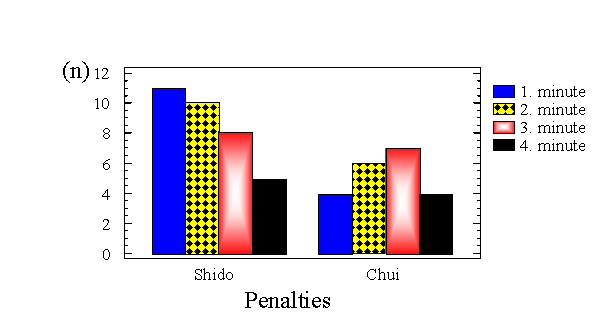 Figure 5. The distribution of the number of penalties in the consecutive minutes of fight (in the entire tournament). As illustrated in figure 5, the majority of penalties were imposed on the contestants in the second minute of fight. With the lapse of time (from the first up to the third minute) Chui verdicts were more and more often. This analysis is important because these verdicts provide points to the opponent (Shido = 1 point, Chui = 2 points). Recapitulation of the findingsOn the basis of the conducted studies we found a number of characteristic features of the course of Ju-jitsu fight, which differentiated weight categories. 1. We observed a differentiation in the utilisation of time of fight depending on the weight category of the contestants. The champion of the category above 94 kg conducted his fight most effectively. The duration of the second and third part of fight as well as that of the time-outs depended on the weight category. The highest number of techniques and points for their execution occurred in the first fragment of fight, during which punches delivered with the hand predominated. Uchi-mata and Seoi nage were the most frequently applied throwing techniques in the second part of fight. 2. The technique executed during the third part of fight (mainly, holding techniques) received the highest scoring value in both categories. The points obtained as the result of the offences of the opponent had no significant bearing on the final result. Most of the actions were executed in the centre of the contest area in the form of a single attack, which indicated a need for tactical perfecting of the competitors (drills in counter-attacks and combinations). The course of fight indicated a necessity for an all-round motor and technical preparation of the contestants participating in Ju-jitsu competitions. 3. The conducted research prompted us to formulate a suggestion about the usefulness of the applied method and continuance of observation of sports fight during next Ju-jitsu competitions. The obtained results make it possible to obtain individual characteristics of competitors and the patterns of actions of their opponents in particular weight categories. The developed technical patterns indicate a direction for the schooling in sports clubs. At the same time, they inform about inadequate defence against typical attacks in the consecutive parts of fight. 4. The individual characteristics of the contestants that we have developed could be implemented in the setting of concrete training assignments, for example simulations of the potential opponents’ behaviour during fight, selection of both effort duration and time-outs in interval training sessions, etc. LiteratureHickey P.M. 1996. Understanding International Ju-jitsu Competition Rules for Free Fighting and Duo Competition. www.usakarate.org/jj/l Kondratowicz K. 1991. Jiu-jitsu – The Art of Defensive Combat. Military Magazines, Warsaw. Rylko A. 1989. The Methods of Statistical Analysis. The Academy of Physical Education, Kraków. Sikorski W. 1985. The Current Issues of Judo Training and Sports Combat. Papers and Materials of the Sports Institute, Warsaw 5. Sterkowicz S. 1992. The Characterization of Selected Indices Defining the Level of Preparation of Karate Contestants. Monograph Publication of The Academy of Physical Education, Kraków, 47. Sterkowicz S. 1998. Ju-jitsu: selected Aspects in the Arts of Defensive Combat. Studies and Monographs, The Academy of Physical Education in Kraków, 2. Sterkowicz S., Kesek M. 1983. The Characterization of activities during International Women Judo Tournament Competitive Sport, 7, 19. Sterkowicz S., Kesek M. 1985. The Assessment of Technical and Tactical Schooling of the Participants of all-Polish Judo Competitions. Competitive Sport, 7-8, 12. Sterkowicz S., Kiejda I., Blach W. 1997. The Characterization of the Styles of Judo Fight at the Olympic Games between 1988 and 1996. Training, 1, 27. Sterkowicz S., Maslej P. 1999a. The Analysis of the Course of Judo Fight on the Basis of its Temporal Structure – a Comparative Study. Competitive Sport, 7-8, 33-37. Sterkowicz S., Maslej P. 1999b. The Technical and Tactical Actions Applied in Judo Fight. Competitive Sport, 9-10, 45-53.. Sterkowicz S. 1999. The Professional Activities of the Judo Coach. Scientific Fascicles, The Academy of Physical Education in Kraków, 77, 5-8. | |||||||||||||||||||||||||||||||||||||||||||||||||||||||||||||||||||||||||||||||||||||||||||||||||||||||||||||||||||||||||||||||||||||||||||||||||||||||||||||||||||||||||||||||||||||||||||||||||||||||||||||||||||||||||||||||||||||||||||||||||||||||||||||||||||||||||||||||||||||||||||||||||||||||||||||||||||||||||||||||||||||||||||||||||||||||||||||||||||||||||||||||||||||||||||||||||||||||||||||||||||||||||||||||||||||||||||||||||||||||||||||||||||||||||||||||||||||||||||||||||||||||||||||||||||||||||

